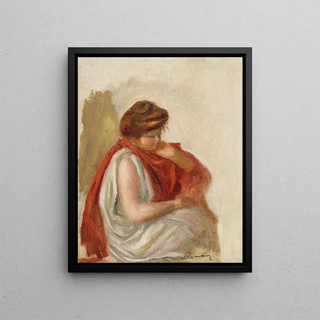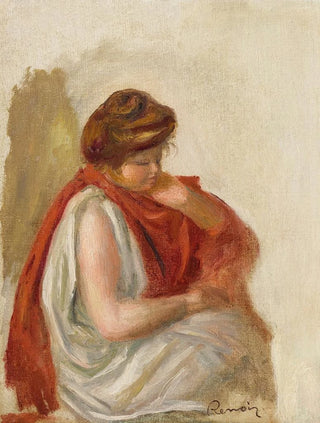Art print | Sketch for Oedipus - Pierre-Auguste Renoir


View from behind

Frame (optional)
The artwork "Sketch for Oedipus" by Pierre-Auguste Renoir invites you on a fascinating journey into the artistic universe of the late 19th century. This sketch, which foreshadows a more elaborate composition, stands out for its ability to capture the very essence of a dramatic scene. Renoir, master of the Impressionist movement, succeeds in conveying a palpable emotion through delicate brushstrokes and a subtle palette. The piece evokes not only the myth of Oedipus but also an aesthetic sensitivity that transcends time, inviting the viewer to contemplate the depth of the human condition.
Style and uniqueness of the work
In "Sketch for Oedipus," Renoir deploys a style that is uniquely his own, combining an Impressionist technique with powerful visual storytelling. The human figures, although stylized, are rendered with such vibrancy that they seem almost to come alive on the canvas. Light plays a fundamental role in this piece, with each brushstroke carefully considered to create reflections and shadows that enrich the composition. The color, meanwhile, is used with remarkable sensitivity, oscillating between warm tones and darker shades, which enhances the dramatic atmosphere of the scene. This sketch, far from being a simple preparatory drawing, reveals itself as a full-fledged artwork, where the artist expresses his creative genius while hinting at the narrative stakes of his subject.
The artist and his influence
Pierre-Auguste Renoir, an emblematic figure of Impressionism, managed to leave a mark on his era through an innovative approach to painting. Born in 1841, he quickly distinguished himself by his ability to capture light and movement, transforming the way artists perceived and depicted reality. His influence on the art world is undeniable, both through his techniques and thematic choices. Renoir immersed himself in everyday life and human relationships, which is reflected in his works. "Sketch for Oedipus" bears witness to his interest in mythology and literature, elements that fuel his imagination

Matte finish

View from behind

Frame (optional)
The artwork "Sketch for Oedipus" by Pierre-Auguste Renoir invites you on a fascinating journey into the artistic universe of the late 19th century. This sketch, which foreshadows a more elaborate composition, stands out for its ability to capture the very essence of a dramatic scene. Renoir, master of the Impressionist movement, succeeds in conveying a palpable emotion through delicate brushstrokes and a subtle palette. The piece evokes not only the myth of Oedipus but also an aesthetic sensitivity that transcends time, inviting the viewer to contemplate the depth of the human condition.
Style and uniqueness of the work
In "Sketch for Oedipus," Renoir deploys a style that is uniquely his own, combining an Impressionist technique with powerful visual storytelling. The human figures, although stylized, are rendered with such vibrancy that they seem almost to come alive on the canvas. Light plays a fundamental role in this piece, with each brushstroke carefully considered to create reflections and shadows that enrich the composition. The color, meanwhile, is used with remarkable sensitivity, oscillating between warm tones and darker shades, which enhances the dramatic atmosphere of the scene. This sketch, far from being a simple preparatory drawing, reveals itself as a full-fledged artwork, where the artist expresses his creative genius while hinting at the narrative stakes of his subject.
The artist and his influence
Pierre-Auguste Renoir, an emblematic figure of Impressionism, managed to leave a mark on his era through an innovative approach to painting. Born in 1841, he quickly distinguished himself by his ability to capture light and movement, transforming the way artists perceived and depicted reality. His influence on the art world is undeniable, both through his techniques and thematic choices. Renoir immersed himself in everyday life and human relationships, which is reflected in his works. "Sketch for Oedipus" bears witness to his interest in mythology and literature, elements that fuel his imagination






